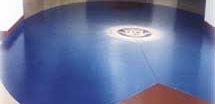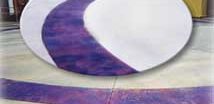- Coloring Supplies
- Concrete Stains
- Concrete Dyes
- Color Hardener
- Integral Color
- Resurfacing & Overlays
- Concrete Coatings
- Concrete Overlay Supplies
- Concrete Resurfacer
- Vertical Concrete Overlays
- Terrazzo Flooring
- Concrete Countertops
- Countertop Mixes & Supplies
- Texturing & Patterns
- Concrete Stamps
- Concrete Stencils
- Concrete Engraving
- Forms & Molds
- Concrete Forms
- Concrete Molds
- Step Forms
- Concrete Polishing
- Polishing Equipment
- Concrete Densifiers
- Tools & Equipment
- Surface Preparation
- Concrete Tools
- Concrete Power Tools
- Concrete Pumps
- Protection & Repair
- Concrete Sealer
- Cleaning Concrete
- Concrete Repair
- Curing Concrete
- Vapor Barriers
- Foundation Waterproofing
- Concrete Mix
- Concrete Admixtures
- GFRC Mixes & Supplies
Creating Excitement with COLOR
New polymer stain for concrete comes in a palette of bold, vibrant huesFor decades, designers and decorative concrete contractors have been using acid-etch chemical stains to dress up plain concrete floor and slab surfaces. Concrete stain is easy to use and the rich, earthy tones produce a variegated look that resemblesnatural stone, marble, wood, or even leather. The luxurious effects possible with this coloring technique are truly remarkable. But what if subtle drama isnt what youre after? What if you want to energize a drab concrete surface with colors that are bright, bold, and lively?
Now you can with Rembrandt, a new acrylic-urethane polymer stain available in a full palette of pigments. The product, which is manufactured by Epmar Corp. of Santa Fe Springs, Calif., was demonstrated for contractors earlier this year at World of Concrete 2003 through distributor Kemiko Concrete Products, Leonard, Texas. And its already winning fans.
The interest and excitement about Rembrandt is overwhelming. I think its going to find its niche quickly, says Kemikos Barbara Sargent, who is also one of the Concrete Network's industry leaders. Barbara has been selling Kemiko Stone Tone acid stains for more than 30 years, but she says that Rembrandt is something totally different and unique. It comes in colors that arent available in the acid line, such as vibrant red, orange, and cobalt blue. The only limit to the color palette is your imagination. People who like to be creative and do faux finishes are going to have a blast with this product.
She also says that Rembrandt is very user-friendly. The system consists of a gallon container of resin into which you squeeze tubes of pigment. Just shake, and its ready to apply. One coat dries to the touch in less than an hour, and you can apply a clear finish coat after 2 to 3 hours.
Another benefit: Rembrandt is void of any objectionable odor because of an ultra-low volatile organic compound (VOC) content. The environmentally friendly formulation also complies with Californias stringent South Coast Air Quality Management District rules for VOC content of architectural coatings, which dont go into effect until 2008. We are trying to stay ahead of the curve for VOC regulations, says Barbara.
Who is using Rembrandt? Barbara says its appeal is extending to residential, commercial, and institutional markets for a variety of interior and exterior applications. Were seeing people use it for childcare centers, theme parks, hospitals, childrens bedrooms, shopping malls, restaurants, and schoolsany place where you want to create excitement with color.
Endless color possibilitiesRembrandt pigment comes in 12 standard colors as well as black and white. By mixing two or more pigments, you can create your own designer colors. Here are just a few of the possibilities.



To achieve faux finish effects such as mottling, aging, or graining, you can apply one color of Rembrandt as a base coat followed by one or more contrasting colors, dabbed on with a cloth, sponge, or brush.
Surface preparation requirementsRembrandt has exceptional adhesive strength, which gives it outstanding wear qualities. For the best long-term adhesion, however, its important to prepare concrete surfaces properly.
New surfaces should be fully cured, dry, and free of laitance. On existing surfaces, remove all visible oil, grease, sludge, and any other contaminants, either by water washing or acid etching. For a non-slip surface, an abrasive surface preparation method, such as shot blasting, can be used.
User-friendly applicationRembrandts excellent workability characteristics and nontoxic qualities make it as easy and safe to apply as a coat of latex paint. Here are the basic steps to follow:
-
Squeeze the pre-measured tube of pigment of your choice into a gallon of resin. Shake to mix.
-
Choose an application methodeither a brush, roller, sponge, cloth, or commercial sprayer.
-
Apply Rembrandt to a dry, properly prepared concrete surface. No primer is needed.
-
Clean application tools with mild soap and water.
-
Apply a clear protective finish coat 2 to 3 hours later.
Rembrandt will give you a coverage rate of about 300 to 400 square feet per gallon, per coat. Because of the products low VOC content, it is completely safe to apply indoors without concern for odors or toxic fumes.
Where to use RembrandtRembrandt is formulated for both interior and exterior use. It has excellent UV stability and wear ability, but should be protected with a clear topcoat for additional abrasion and chemical resistance and for easier cleaning. For the topcoat, you can use an acrylic urethane, polyurethane, or epoxy, depending on the application.
Rembrandt can also be used on concrete surfaces that may not take conventional acid stains well, such as areas previously cleaned with muriatic acid or where a substance is inhibiting the chemical reaction of the acid stain.
For slab surfaces where extra traction is desired, such as pool decks or sloped driveways, you can create a non-slip finish by broadcasting silica sand, fine glass beads, or other aggregates onto the surface between coating applications.
Here are just of few of the concrete surfaces you can transform with Rembrandt stains:
-
Walkways
-
Decks
-
Driveways
-
Commercial and residential floors
-
Shopping malls and restaurants
-
Theme parks
-
Playgrounds
-
Floors in childcare centers and schools
Kemiko Concrete Products
P.O. Box 1109
Leonard, TX 75452
Phone: 903-587-3708
Send Mail Now - Click Here
www.kemiko.com
Anne Balogh writes feature articles each month for The Concrete Network. She is a freelance writer based in Glen Ellyn, Ill., and a former editor of Concrete Construction magazine.




